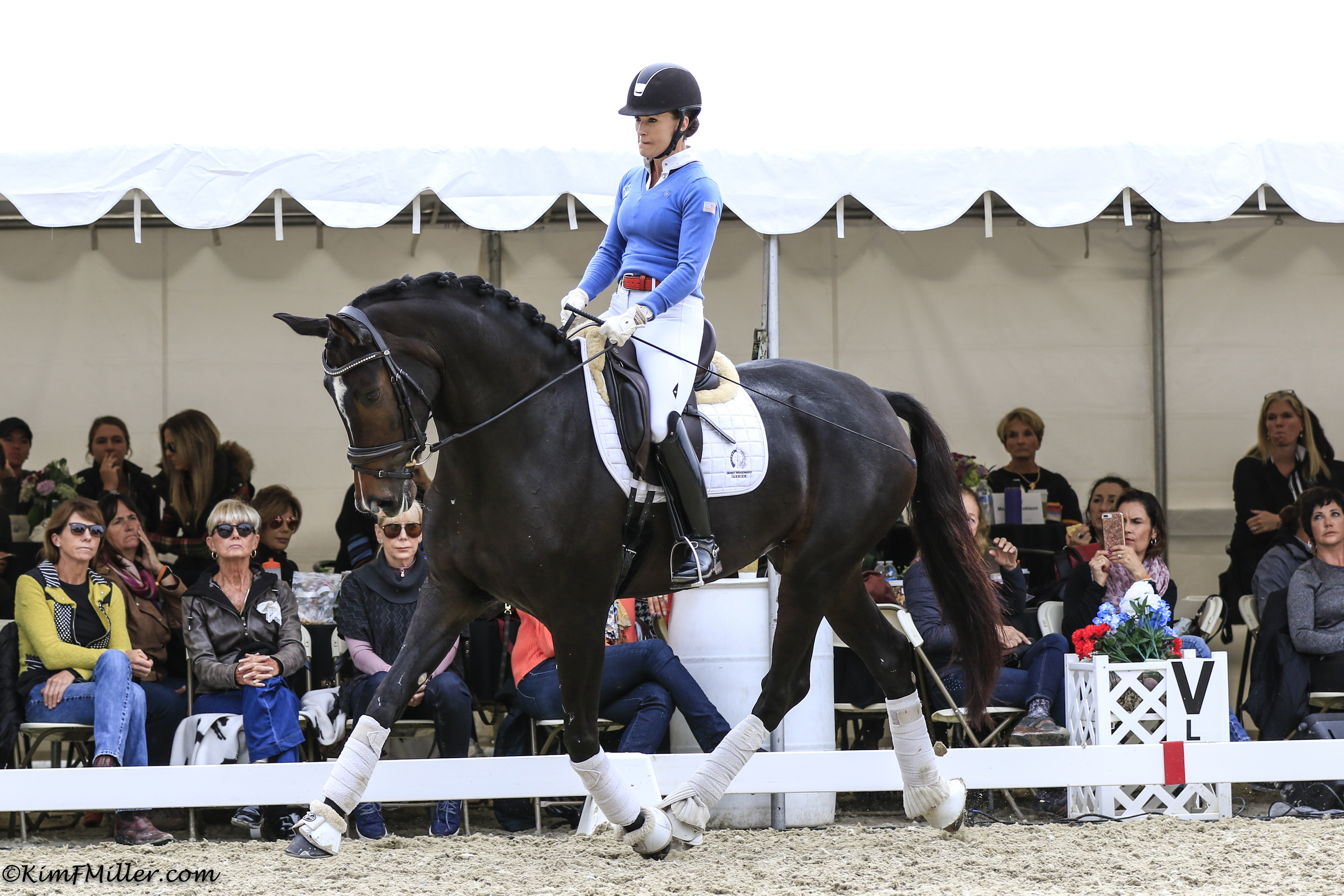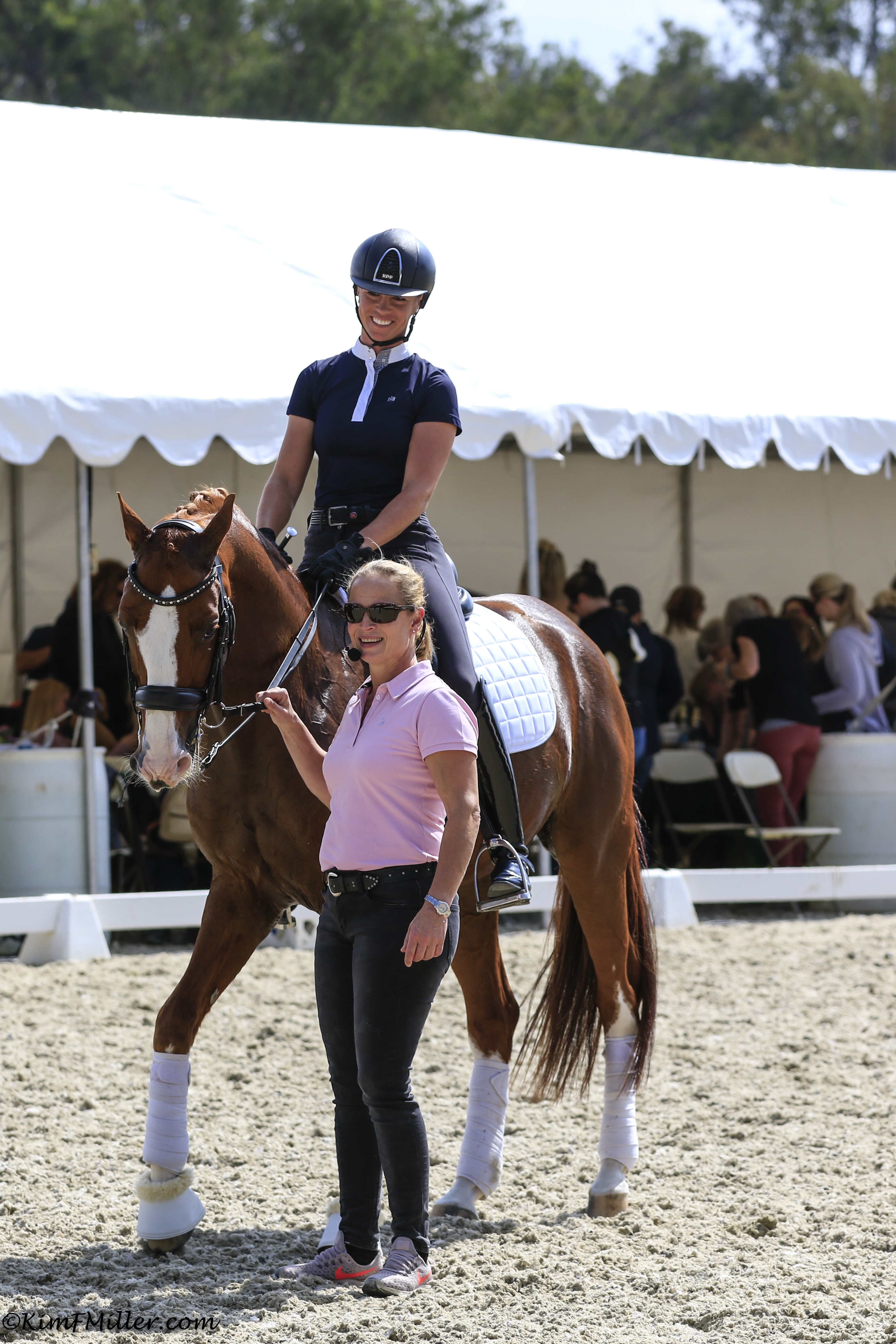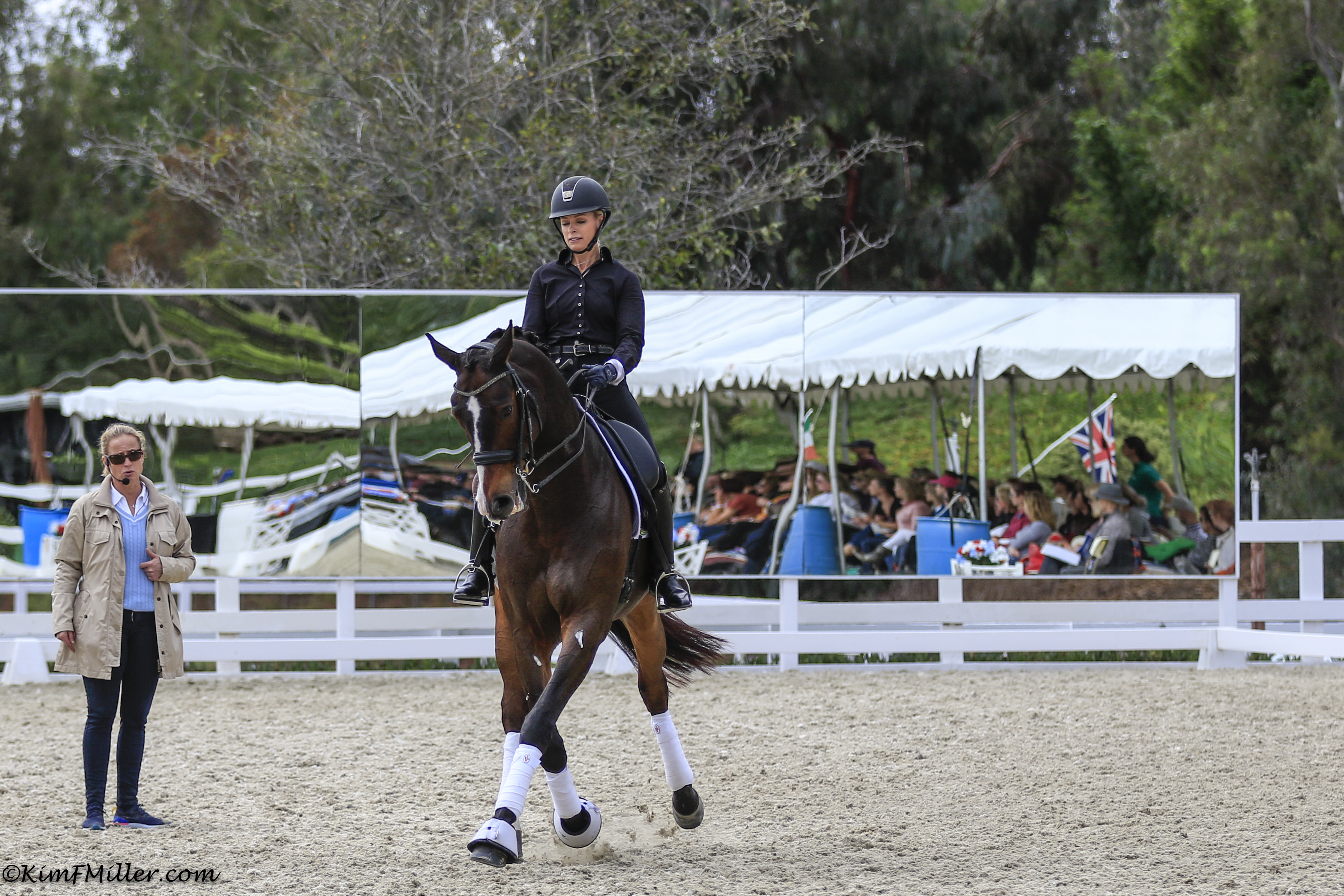
Southern California dressage riders are a little spoiled. Olympians Steffen Peters, Guenter Seidel, Christine Traurig, Jan Ebeling and Kathleen Raine train and compete regularly in the area. Charlotte Dujardin, Carl Hester, Edward Gal and Hans Peter Minderhoud have visited to region recently as part of organizer Scott Hayes’ Masterclass weekends. Yet there was no sign of fans being desensitized to stars of the sport as the reigning queen of dressage Isabell Werth came to town Oct. 13-14 as the latest Masterclass presenter.
Fresh from winning WEG double gold with Bella Rose this past September in Tryon, and ready to start the quest to defend her World Cup Finals crown, Isabell coached seven horse/riders pairs with precise, stride-by-stride instructions. The intimate setting of a private stable in Rancho Santa Fe gave the sold-out crowd of nearly 500 an up-close view of this candid and colorful celebrity. The riders were mostly very accomplished, and all rode top quality horses with a variety of training and experience levels.
Here are eight takeaways from the weekend. Familiar as they may be, “We can never hear them too often,” said one amateur rider of Isabell’s broadly applicable advice as she headed home to put it into practice.
Outside Rein
Even contact on both reins was Isabell’s ideal, but getting to that goal often entailed more use of the outside rein, sometimes more than seemed intuitive. In helping one horse build hindquarter “swing” in its trot stride, she had the rider use more outside rein on a 20-meter circle: a half-halt-degree of pressure. The exercise progressed to a “touch” of counter-flexion and even a slight shoulder-in to the outside, still on the circle. The goal was getting the horse more supple and through in the body and working into the bit. The rein cues were all in coordination with steady leg and “heavy” seat aids to keep the forward impulsion.
In the canter, the outside rein is most important, Isabell explained. “When the horse jumps against the inside rein, the inside leg is less active, giving less quality to the canter.”
Forward Fix
“It doesn’t matter,” was Isabell’s response to spooks, breaks of gait and misunderstandings by the horse. Going forward was almost always the first step toward a fix, especially if the misstep involved the horse falling behind the bit and/or the rider’s leg. As horses were spooky or balking, Isabell insisted on forward aids and an attitude of “we don’t discuss this” toward the horse’s unwanted behavior.
Thousands of Little Transitions
Beyond a few laps of warm-up work, it was rare that any pair made more than a few full loops round the ring at the same pace or gait. Transitions within and between gaits and into and out of exercises, in circles, on diagonals and straightaways and in lateral work were the medium for helping fine-tune each partnership. Establishing quick responses to subtle aids while maintaining a steady rhythm was the overarching goal, along with suppling the horse.

Try Trust
Allowing a horse to “present himself” or “show himself off” is another of Isabell’s training goals. First, the horse must accept the leg and seat go-forward cues and move fluidly into the bit, rather than escaping from those pressures by “running through” the bit. Next, it’s a feel-based, precisely-timed, very slight release of rein pressure. In trusting the horse to move forward freely in self-carriage, the rider invites and allows the horse to express itself.
Even though Isabell often coached stride-by-stride control, she also encouraged letting go of control when the rider sensed the horse would handle it right in the form of “opening herself up,” as she explained to several pairs. In some cases, it was a matter of experimenting with the horse’s reactions. “Push when necessary, but also try trusting him,” she said to one rider on a strong horse who tended to fall behind the bit. “He can only open himself when he has the chance. It’s about using the power of the hands in a positive way.”
Keep The Rhythm
At all gaits, rhythm is the most important. “Tick, tick, ticking…” to keep the beat for several riders, Isabell coached back-to-front powered impulsion and a steady, honest contact with the hand to get and maintain an even rhythm. That’s always the priority within gaits, in transitions between extensions and collections, through gait changes and into, through and out of exercises: fluid movement and even rhythm.
Pilot errors cause many breaks in rhythm. Rushing a transition and applying too much or too little leg or rein are frequent culprits. Sometimes this stems from not trusting oneself. Too often, “Everybody stops breathing because they say, ‘Now, the collected walk or maybe piaffe is coming in 10 meters,’” Isabell observed. “They get more awake or tense because of that. What you have to do is trust yourself that in 10 meters, it will work out.”

Shoulder Ins & Half-Passes
To varying degrees, these were workhorse exercises for all seven horse/rider pairs and they served several purposes. The shoulder-in first cropped up, at the walk, as a way to get Rebecca Ridgon’s spooky 5-year-old Iquem to accept the leg aid without getting further flustered by the very different surroundings in her home arena. Shoulder-ins, at the canter on the long-side straightway, helped Niki Clarke’s big horse Coral Reef Scoobidooh improve the quality of his “jump” in each stride. With the support of a firm inside leg aid, the exercise helped elevate his inside shoulder, which carried nicely into a transition from shoulder-in to half-pirouette.
Several horses worked from several steps of shoulder-in into half-pass. The half-pass, Isabell explained, helps the horse learn to use its hind legs first. That’s critical to the quality of all gaits, transitions and movements, from the basic canter depart to passage, piaffe and pirouettes.
Flexions
Alternating lateral flexions helped several nervous or spirited horses relax. Bending through the rib cage loosens the horse’s body and encourages breathing, plus the aids require the horse to focus more on their rider and less on their spooky surroundings. Lateral suppleness helps with hindquarter engagement required in back-to-front impulsion in all gaits, and loosens back muscles for swing in the trot and free movement in all gaits.
Looked at from above, a horse in lateral flexion should have the shape of a banana, usually curved in the direction of travel, but not always. Counter-flexions were often used on straightaways and in circles of all sizes to encourage suppleness and build strength and balance.
Lots of lateral flexions helped supple Matt Cunningham’s 9-year-old Prix St. Georges horse, Ribéry 27. Coaching Matt to sit more deeply and back with his torso, with steady leg pressure, Isabell said, “Let him run into the flexion so you can feel him going through your hand and into the bit.” The horse had started out stiff and too short from back to front. The flexions helped him take on a more engaged, rectangular-shaped frame that Isabell sought, making the most of a “super mover.”
“He has a lot of talent,” she concluded. “The challenge is to make him flexible enough and quick enough.”
Work The Walk
“People forget to work in the walk, but you can do so much in it,” Isabell said. David Blake’s flashy mare, Heide Spirit, was hot to trot or more, but Isabell had them work at the walk for about 20 minutes, concentrating on transitions aimed at getting her to develop a “more honest contact” with the bit and engagement through her whole body. Her initial trot was uphill looking and “passagy,” but Isabell wanted a “more normal rhythm and using her body more: quick, but little. She’s moving so big, she’s running against the rein.”
Hence, a walk session of “collect and let go, collect and let go” as Isabell coached the small transitions between collected and normal walk. “Slowly give her a little rein, let her chew [the bit].” She encouraged David to “shake the rein a little bit,” which appeared as a subtle vibration, to encourage the mare to reach into the bit.
“You could work at the walk for an hour a day, but nobody does it,” Isabell said of the gait’s potential to address many training issues.
Isabell’s visit was short. She flew in from Germany on Friday evening and was headed home Sunday afternoon. As she mingled with fans, signed autographs and posed for photographs during breaks, it was clear the crowd had not had enough of her and would welcome her return ASAP!
For more tips from Isabell, check out Dressage Today’s coverage of the clinic as well.










